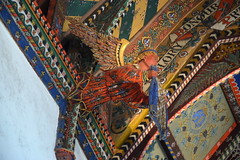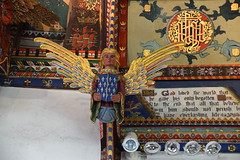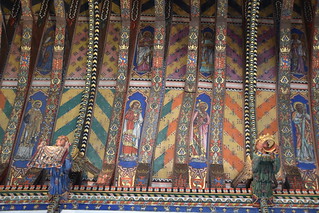| |
|
Follow these journeys as they happen at Last Of England
Twitter.
It was the first day
of the 2019 Easter holidays, and what better way to spend
a Monday morning than heading off for a church-exploring
bike ride rather than going to work? I caught the train
up to Halesworth, and then cycled off out into the hills.
The villages and their pretty parish churches come thick
and fast around here, and almost all of them are open to
pilgrims and strangers daily. There is a good mixture
too, round towers, square towers, hardly-any-left towers,
reed-thatched roofs, beflinted-porches, and all manner of
treasures inside. A fair number of East Anglia's best
small churches are in this area. But even given this
variety, there is nowhere else in East Anglia quite like
Huntingfield church.
This is one of Suffolk's more obscure villages, but the
Huntingfield name was that of one of the county's most
significant families. Huntingfield is the nearest village
to the great pile of Heveningham Hall, with one of the
largest Georgian frontages in England. It was rebuilt by
the Huntingfields in the 18th Century. Standing on the
road and looking across the sheep-scattered lawns to the
great building, it is easy to imagine the gulf between
the landed gentry and their poor workers in those days.
Sandwiched between the traumas of the 17th Century and
the energy of the 19th Century, it was the landowners of
the 18th Century who had every reason to think that their
world was permanent and unchanging, that it would always
be as they knew it. Farming sheep, collecting art,
patronising musicians, tinkering with primitive science
and technology, dispensing benevolent largesse to the
poor on their estate - it is a world that is at once
attractive and appalling. For them, the Church of England
was both an arm of the state dispensing laws, justice and
charity, and the setting for the weekly liturgical
reinforcement of the puritan-refracted Elizabethan
settlement.
But the Industrial Revolution would bring it all to an
end, and in more ways than one. As the Victorian Age got
underway, many parish churches were drawn by the
excitement of the age into major reconstructions and
revisions. Their impulse came from Oxford, where the
Tractarians had a vision of the Church of England as a
national Church, no longer a protestant sect but restored
to the catholicity of its roots, and from Cambridge,
where the ecclesiologists decided what a building of the
national Church should properly look like. As the young
men graduated and were presented to parishes across the
country, their ideas spread like wildfire. They had come
from their universities to churches fitted out for
protestant worship, with whitewashed walls and box pews
focused on the high pulpit, the rarely-used altar
gathering dust in the chancel or even discarded.
Preaching houses rather than sacramental spaces, and any
surviving traces of the building's medieval life
survived, perhaps, simply because they were not
understood.
Essentially, what happened in England between about 1830
and 1870 was a cultural revolution, a new wave of ideas
and the reaction to them. The liturgical changes proposed
by the Oxford Movement were, at first, objectionable, and
then merely controversial. But gradually they seeped into
the mainstream, until by about 1890 they had become as
natural as the air we breathe. Galvanised by the ferment
of ideas and the possibilities of the industrial age,
these young men convinced their rich patrons,
revolutionised their buildings, and in so doing altered
their parishes forever. They often looked to London stars
like Scott and Butterfield, or local plodders like
Phipson and Chancellor, or else mavericks like Salvin.
The demands of the new liturgical arrangements, coupled
with a renewed sense of the need to glorify God, led them
into what was often a rebuilding rather than a
restoration.
Internal decorations were, perhaps, the bespoke work of
the architect. Witness Phipson's meticulous attention to
detail at St Mary le Tower, Ipswich. Other restorers
relied on the big picture, a vision that encompassed
walls and floors, but left the fittings to others. By the
centenary of the movement in the 1930s, one prominent
Anglican clergyman could observe "It is as if the
Reformation had never happened". Well, not quite.
And now, the pendulum has swung the other way, leaving
the ritualists high and dry. But the evidence of the
energy of those days survives, especially at
Huntingfield, where William Holland, the vicar, drove the
Oxford Movement through the heart of the parish, like a
motorway through a Site of Special Scientific Interest.
The Hollands were the patrons of the living, which gave
them the authority and the money to reimagine
Huntingfield church on a grand scale. Oxford and
Cambridge universities were exclusively for men, of
course, but it so happened that William Holland had an
energetic and visionary wife. Between 1859 and 1866, Mrs
Mildred Holland planned, designed and executed the most
elaborate redecoration of a church this county had seen
since the Reformation. For seven years, she lay on her
back at the top of scaffolding, first in the chancel
(angels) and then in the nave (saints on the ceilure,
fine angels on the beam ends), gilding, lettering and
painting this most glorious of small church roofs. You
can activate the floodlighting with a pound coin in a box
at the west end of the north aisle, and the illuminated
work is breath-taking.
  
    
  
William Holland kept a
journal throughout this period, and there is no
suggestion that Mildred had any assistance, beyond that
of workmen to raise the scaffolding, and advice from the
architect E.L. Blackburne who was an enthusiastic
medievalist. Another 19th Century architect, J.P. St
Aubyn, was responsible for the structural restoration of
this largely 15th Century building, and it was restrained
and merciful. But you come here to see the painted roofs,
which are perfectly splendid.
And when, at last, you can drag your eyes away from it,
what else is there to see? Some 15th Century window
borders in the east window of the south aisle depict
hares and a little dog with a bell around his neck. And
what is that at the bottom, a dragon, or a winged lion?
Evidence of the church's continued High Church tradition
into the 20th Century is in statues of the Blessed Virgin
and child flanked by St Francis and St Dominic in a
triple image niche set in a pillar of the north arcade.
Was it originally for a rood group, perhaps above an
altar? You might think that the towering font cover is
also by her, but in fact it is her memorial, placed here
by her husband, as is the art nouveau lectern. It is as
if her art was a catalyst, inspiring others to acts of
beauty. She died in the 1870s, predeceasing her husband
by twenty years. They are both now buried by the
churchyard gate. How fitting, that they should lie in the
graveyard of the church they loved so much, and to which
they gave so much of their time, energy and money.
Any church is a
palimpsest, history written and rewritten over its skin
as a fleeting record of the changing liturgical
imperatives and the long generations of its people.
Across this canvas, the enthusiasms at Huntingfield in
Mildred Holland's time are writ large and will last long.
And there is something else, and a great curiosity. Ann
Owen, the Vicar's wife in the neighbouring parish of Heveningham, is also said to have been responsible for
some of the 19th Century work in the church there, this
time in the form of stained glass. I visited Heveningham church on the same day as I revisited
Huntingfield, I am afraid it is difficult for me to find
this convincing, although of course one likes to think it
was so, and that the two women artists were friends, or
possibly even rivals. But Mildred's story has been
brilliantly captured in a recent novel, The Huntingfield
Paintress by Pamela
Holmes. Pamela tells me that 'it was a comment of yours
about Mildred and Ann Owen which sparked my determination
to write my first novel' which is very kind of her,
although I am sure it was easy to be inspired standing
here at Huntingfield under the vast heaven of Mildred
Holland's work.
Simon Knott, April 2019
Follow these journeys as they happen at Last Of England
Twitter.
|
|
|

